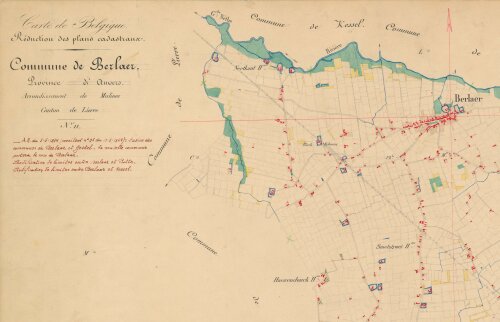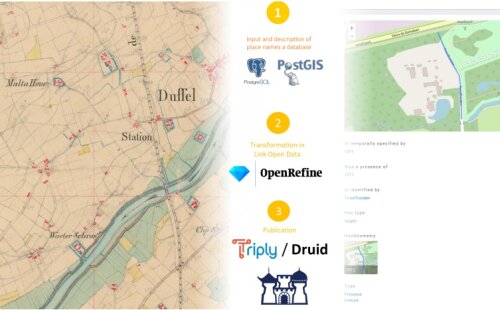The collect of a first set of toponyms
The first phase of the project consists in the gathering of an ancient and geographically homogeneous set of toponyms. This is done by collecting all the toponyms mentioned on the ‘reduced cadastre’, a reduced version of the primitive cadastre drawn between 1847 and 1855 to prepare the creation of the first topographical map of Belgium in the second half of the nineteenth century. Access to these maps is made possible thanks to the IGN/NGI that we would like to thank here.

Gereduceerd kadaster, extract from the sheet for the town of Berlaer, 1851 © IGN/NGI
Integration in a database
These toponyms are located by using points in QGis and described via the PostGis extension in a PostgreSQL database whose structure is very simple, highly adaptable to every source and compatible with Linked Open Data principles. In order to help researchers disambiguating place names, we add to the description of these toponyms a link to their Wikidata page if one already exists and/or to the corresponding paragraph of Gemeenten van Belgïe (Duvosquel, Jean-Marie, Hervé Hasquin, and Raymond Van Uytven. Gemeenten Van België: Geschiedkundig En Administratief-Geografisch Woordenboek. Bruxelles: La Renaissance du Livre, 1980), where Hervé Hasquin and his team summarized historical information (notably administrative and ecclesiastical belonging during the Ancien Régime) about municipalities.
Description of the links between the toponyms
The second phase consists in establishing links between the recorded toponyms (for instance territorial belonging like ‘this hamlet belongs to this village’), as well as between the latter and the toponyms recorded in the present-day database of the IGN/NGI: by establishing these links we can described how a toponym evolved during the nineteenth and the twentieth century in order to explore variations of the place names through time.
Future steps
From the gereduceerd kadaster (© IGN/NGI) to Druid
In a third phase, toponyms extracted from older material will be added to the database and the same sort of links will be described.
The gazetteer, developed in Linked Open Data (LOD) will be progressively uploaded on the LOD platform Druid, and, at the end of the project, it will be published on the World Historical Gazetteer in order to make it easily reachable for everyone as well as potentially extendable.

From the gereduceerd kadaster (© IGN/NGI) to Druid